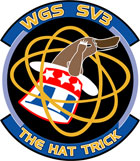
The Mobile User Objective System (MUOS) is a United States Space Force narrowband military communications satellite system that supports a worldwide, multi-service population of users in the ultra high frequency (UHF) band. The system provides increased communications capabilities to newer, smaller terminals while still supporting interoperability with legacy terminals. MUOS is designed to support users who require greater mobility, higher bit rates and improved operational availability. The MUOS was declared fully operational for use in 2019.

United Launch Alliance, LLC (ULA) is an American launch service provider formed in December 2006 as a joint venture between Lockheed Martin Space and Boeing Defense, Space & Security. The company designs, assembles, sells and launches rockets, but the company subcontracts out the production of rocket engines and solid rocket boosters.

Space Launch Complex 37 (SLC-37), previously Launch Complex 37 (LC-37), is a launch complex on Cape Canaveral Space Force Station, Florida. Construction began in 1959 and the site was accepted by NASA to support the Saturn I program in 1963. The complex consists of two launch pads. LC-37A has never been used, but LC-37B launched uncrewed Saturn I flights and was modified and launched Saturn IB flights, including the first (uncrewed) test of the Apollo Lunar Module in space. It was deactivated in 1972. In 2001 it was modified as the launch site for Delta IV, a launch system operated by United Launch Alliance.

The Defense Satellite Communications System (DSCS) is a United States Space Force satellite constellation that provides the United States with military communications to support globally distributed military users. Beginning in 2007, DSCS began being replaced by the Wideband Global SATCOM system. A total of 14 DSCS-III satellites were launched between the early 1980s and 2003. Two satellites were launched aboard the Space Shuttle Atlantis in 1985 during the STS-51-J flight. As of 14 September 2021, six DSCS-III satellites were still operational. DSCS operations are currently run by the 4th Space Operations Squadron out of Schriever Space Force Base.

The Wideband Global SATCOM system (WGS) is a high capacity United States Space Force satellite communications system planned for use in partnership by the United States Department of Defense (DoD), Canadian Department of National Defence (DND) and the Australian Department of Defence. The system is composed of the Space Segment satellites, the Terminal Segment users and the Control Segment operators.

Advanced Extremely High Frequency (AEHF) is a constellation of communications satellites operated by the United States Space Force. They are used to relay secure communications for the United States Armed Forces, the British Armed Forces, the Canadian Armed Forces, the Netherlands Armed Forces and the Australian Defence Force. The system consists of six satellites in geostationary orbits. The final satellite was launched on 26 March 2020. AEHF is backward compatible with, and replaces, the older Milstar system and will operate at 44 GHz uplink and 20 GHz downlink. The AEHF system is a joint service communications system that provides survivable, global, secure, protected, and jam-resistant communications for high-priority military ground, sea and air assets.

USA-195, or Wideband Global SATCOM 1 (WGS-1) is a United States military communications satellite operated by the United States Air Force as part of the Wideband Global SATCOM programme. Launched in 2007, it was the first WGS satellite to reach orbit. It is stationed at a longitude of 174.8° East.

The Military Satellite Communications Directorate is a United States Space Force organization headquartered at Los Angeles Air Force Base, California. It is one of several wings and other units that make up the Space and Missile Systems Center (SMC).

USA-233, or Wideband Global SATCOM 4 (WGS-4) is a United States military communications satellite operated by the United States Air Force as part of the Wideband Global SATCOM program, launched in 2012. The fourth Wideband Global SATCOM satellite, it is the first WGS Block II satellite to be launched. It is stationed at 88.5° East in geostationary orbit.

USA-243, also known as WGS-5, is a United States military communications satellite. It was the fifth satellite to be launched as part of the Wideband Global SATCOM program and the second Block II satellite.

USA-204, or Wideband Global SATCOM 2 (WGS-2) is a United States military communications satellite which is operated by the United States Air Force as part of the Wideband Global SATCOM programme. Launched in 2009, it was the second WGS satellite to reach orbit, and operates in geostationary orbit at a longitude of 60° East.

USA-244, or Wideband Global SATCOM 6 (WGS-6) is a United States military communications satellite operated by the United States Air Force as part of the Wideband Global SATCOM programme. Launched in 2013, it was the sixth WGS satellite to reach orbit. It is stationed at a longitude of 135° West, in geostationary orbit. WGS-6 was procured by the Australian Defence Force for the U.S. Air Force, in exchange for participation in the programme.
Intelsat 29e, also known as IS-29e was a high throughput (HTS) geostationary communications satellite designed and manufactured by Boeing Satellite Development Center on the BSS 702MP satellite bus. It is the first satellite of the EpicNG service, and covers North America and Latin America from the 50° West longitude, where it replaced Intelsat 1R. It also replaced Intelsat 805 which was moved from 56.5° West to 169° East. It has a mixed C-band, Ku-band and Ka-band payload with all bands featuring wide and the Ku- also featuring spot beams.

O3b mPOWER is a communications satellite system owned and operated by SES. The system uses high-throughput and low-latency satellites in a medium Earth orbit (MEO), along with ground infrastructure and intelligent software, to provide multiple terabits of global broadband connectivity for applications including cellular backhaul and international IP trunking, cruise line connectivity, disaster recovery, and military communications. The first O3b mPOWER satellites were launched in December 2022 and the system became operational in April 2024 with 6 satellites. The system's capacity will be increased by a further 7 satellites launched by 2026.

USA-263, or Wideband Global SATCOM 7 (WGS-7) is a United States military communications satellite operated by the United States Air Force as part of the Wideband Global SATCOM programme. Launched in 2015, it was the seventh WGS satellite to reach orbit. It is stationed at a longitude of 135° West, in geostationary orbit. WGS-7 was procured by the United States Air Force.

USA 272, or Wideband Global SATCOM 8 is a United States military communications satellite operated by the United States Air Force as part of the Wideband Global SATCOM programme. Launched Delta IV in 2016, it was the eighth WGS satellite to reach (target) orbit. It is stationed at a longitude of 135° West, 149°E i=0° in geostationary orbit. WGS F8 was procured by the United States Air Force.

USA-275, or Wideband Global SATCOM 9 (WGS-9) is a United States military communications satellite operated by the United States Air Force as part of the Wideband Global SATCOM programme. Launched in 2017, it was the ninth WGS satellite to reach orbit. It is stationed at a longitude of 135° West, in geostationary orbit. WGS-9 was procured by the United States Air Force.

USA-291, or Wideband Global SATCOM 10 (WGS-10) is a United States military communications satellite operated by the United States Air Force as part of the Wideband Global SATCOM programme. Launched in 2019, it was the tenth WGS satellite to reach orbit. It is in geostationary orbit. WGS-10 was procured by the United States Air Force.

Wideband Global SATCOM 11, is a United States military communications satellite to be operated by the United States Space Force as part of the Wideband Global SATCOM Program. Scheduled for launch in 2025 by a Vulcan Centaur rocket into in geostationary orbit, it will be the eleventh WGS satellite. WGS 11 was acquired by the United States Air Force.











